It seems like just yesterday that two tiny doelings were bouncing around on the furniture, and getting up to all sorts of mischief.
One of our primary reasons for bringing dairy goats to the farm, of course, is for fresh goat’s milk.
However, to produce milk, first the does need to be bred, and produce offspring of their own.
With good management, it’s generally accepted that there’s no reason that a young doe can’t be bred to freshen the first time when she is around twelve to thirteen months of age. As such, this fall we decided to breed Lotus. We could have bred both Lotus and Minnie, but didn’t feel we necessarily needed to this season. Of the two, Lotus’ overall build led us to breeding her first. Lotus is less gracile, and a little larger than Minnie. She has excellent body capacity, good length from her hips to pins, and good rump width.
Regardless though, there’s no reason we couldn’t have bred Minnie as well this fall, but instead next season we’ll maintain Minnie as a dry yearling, as she can still be shown in the junior classes at show.
For breeding Lotus though, first we needed a buck, obviously. We don’t currently maintain any bucks on the farm, although we do have plans to remedy that in the not too distant future. For now though, our task was to find Lotus a suitable date.
Our goals with breeding, as we slowly build up our herd over time, will be to strive for excellence in the quality of our herd genetics, and continually strive for improvements in both dairy production, and conformation. That process began by founding our herd with quality does, of course, but also extends far beyond that, by continuing to make sound breeding decisions in the future.
Showing goats in the ring, like we did this last summer, has a purpose beyond the sheer pageantry of the event. Yes, everyone wants to win ribbons, but, more importantly, exposing your goats to the scrutiny of numerous judges, as well as other breeders, provides valuable feedback. No matter how ‘cute’ you may think your goat is, and we do think Lotus and Minnie excel on the cute front (not that we’re biased or anything) there are no points for cute!
The objective critical commentary received regarding appearance, and conformation during show, especially a doe’s short-comings, can help to guide breeding decisions down the road.
Lotus is the daughter of a finished champion doe, ARMCH Lost Valley TB Infinity 4*D, and CRF Castle Rock Harvest Moon *S. As Lotus is still quite young she herself is as yet unproven in the show ring, but we’re hopeful that as she matures further she will prove to be at least as good as her mother. We also want the same for her offspring.
Good genetics are important, but our first consideration in the selection of a buck this season was choosing a buck that is not closely related to Lotus.
This young buck is Camanna GD Music Man, and was born earlier this year, produced from a breeding between CH Camanna CS Moonlight Sonata, and Proctor Hill Farm TO Go Daddy.
It’s sometimes helpful to see what kind of kids a particular buck produces prior to selecting him for breeding, but this is the first breeding season for this buck so he has not yet sired any offspring. Just like Lotus, as yet this buck is unproven. However, with any buck, no matter how good he, or his offspring may look, it is still important to look at his dam. When I first saw his mother, there was no question that she has plenty of dairy character, beautiful conformation, and a gorgeous udder too.
So, we arranged a date for Lotus, bred her at the end of October, and then waited impatiently to see whether or not she had settled (conceived). Lotus certainly wasn’t saying anything, no matter how many times we asked her. She clearly was trying to keep it a secret.
After Lotus was bred, her next expected period of heat came and went, without any physical signs of heat, so we were very optimistic.
Trans-abdominal ultrasound pregnancy checks in does are typically performed between 30 and 45 days post-breeding. The results of an initial check at 30 days though was inconclusive. [1] That’s what I get for being impatient, and peeking early. Although we could see fluid in her uterus, we didn’t clearly observe any fetal structures. Lotus didn’t look non-pregnant, but not overtly pregnant either. Although many does can be confirmed pregnant via ultrasound at 30 days, some does, like Lotus, aren’t quite as obvious until they’re at least 35 days pregnant. At 45 days though there should be no question, and a repeat ultrasound two weeks later finally gave us our answer.
Almost as soon as the transducer touched her skin it was clear that Lotus IS pregnant!
Not only is Lotus pregnant, she is carrying at least TWINS! We struggled a little to get more than one in view at the same time, and get the image frozen quickly enough for a good photograph. Below you can see a single fetus, and a cup-like structure called a placentome. It’s possible she may be carrying more than twins. In early pregnancy it can be challenging to differentiate twins from triplets, especially as they’re moving around. Regardless though, she is carrying more than one.
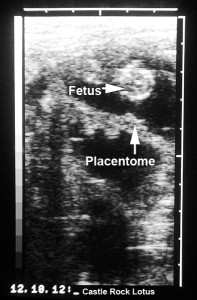
This image shows one of the fetuses, looking down from the top of the head, and a placental structure called a placentome (click image to enlarge)
Ruminants (cows, goats, sheep etc.) have cotyledonary placentas*. Unlike many mammals that have a single large area of placental attachment, ruminants have lots of button-like attachments, and these show up as cup-shaped structures on ultrasound, like the one shown above. When confirming pregnancy via ultrasound, the goal is to observe both the fetus(es), and placentomes.
Not everyone uses ultrasound to confirm pregnancy in goats, but there are management advantages to doing so. For example not every doe that isn’t cycling is necessarily pregnant. She might be, but there are other conditions that can interfere with normal heat cycles. For pregnant does, some of the most common pregnancy-related metabolic disorders, including pregnancy toxemia, and ketosis, can often be prevented through appropriate nutritional management during gestation. As dietary energy needs are influenced by the number of kids a doe is carrying, having some knowledge in advance as to whether a doe is carrying a single, or multiple fetuses, can significantly improve doe management, especially during late gestation. Not to mention that a few seconds with an ultrasound transducer helps to curtail months of anxious nail-biting in the meantime.
The gestation period for goats is approximately 5 months, so Lotus will be due to kid around March 25, 2013. Of course, with genetic variability, there is never any guarantee as to how the offspring from any pairing will work out, but we’re very excited to see what transpires from this breeding. There’s certainly lots of potential for some beautiful babies. Now we just have to cross our fingers that at least one of Lotus’ kids will be a doeling. I have a hunch my fingernails may still be in jeopardy until these little ones are finally on the ground though!
———————–
[1] J.W. Hesselink & M.A.M. Taverne (1994): Ultrasonography of the uterus of the goat, Veterinary Quarterly, 16:1, 41-45
*For more on ruminant placentation, see Placentation in Ruminants in Pathophysiology of the Reproductive System. 2006. Colorado State University.

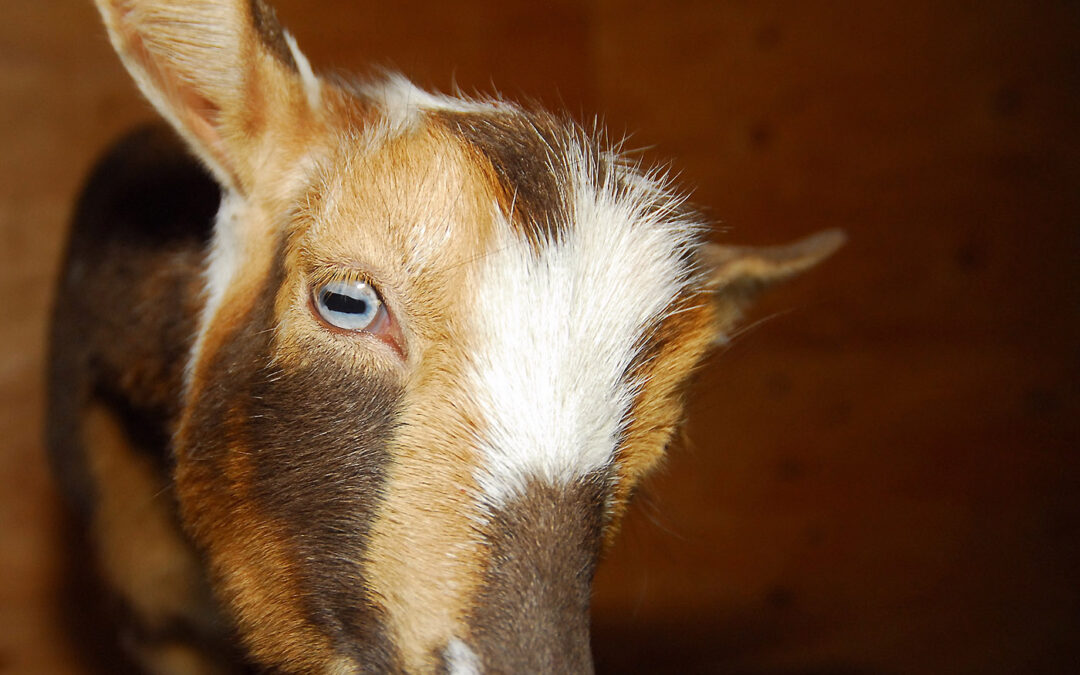
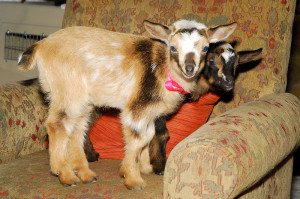
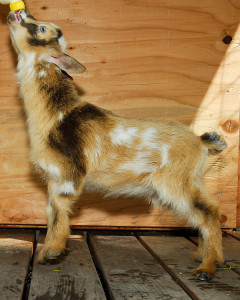
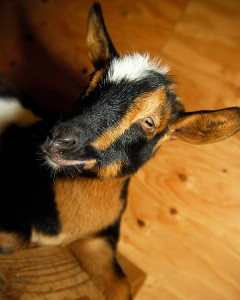
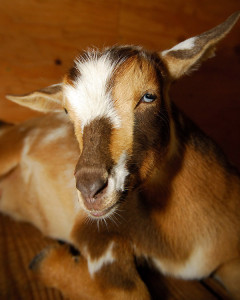
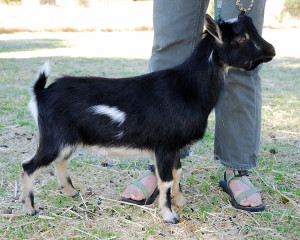
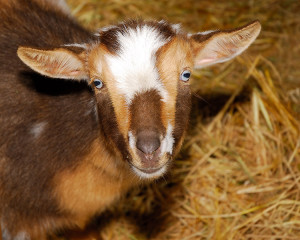








Oh that’s just wonderful news Clare – congratulations.
Ohhh how wonderful and exciting!:) Congratulations!
Thank you Rosie, & Esther! In case you couldn’t tell, we’re very excited! 😉
How very exciting! Congratulations! As always, I learn so much from your posts. I never knew animal husbandry was so complex.
Depending on your goals with farm animals, the husbandry end can be quite complex. I didn’t even get into the logistical aspects of breeding, like ensuring your does aren’t pregnant in the middle of show season. It’s not all as simple as it might appear at first. 😛
Yipppeee and congrats to Lotus the buck and you…can’t wait to see the kids 😉
I love your posts as they teach me so much Clare!
I can’t wait either, I’m really curious to see what color these young ones turn out to be. The Nigerian Dwarf is very colorful breed, but between all the red and white Lotus has, and the very dark color of the buck, it seems that almost anything is possible!
It will be exciting to see the kids. I always enjoy all the animals on your farm, but the goats are by far the CUTEST.
I agree, we think they’re the cutest too…and the girls both know it. They have us completely wrapped around their little hooves 😉
Well, that was certainly informative. And surely the first time I ever looked at a goat ultrasound. Thank you for sharing, and I’ll be waiting anxiously for more updates!
I’d hoped to get a couple of additional ultrasound pics, but it was a little challenging juggling Lotus, and my camera at the same time 😉 Maybe next time I’d try and capture a little video too. It’s much more meaningful when you can see the movement.
How exciting. I love leading a farmers life vicariously through you. I’m looking forward to March to see how things turn out.
It’s very exciting, especially for us, as these will be the first goats (assuming we have at least one doe) to carry the Curbstone Valley herd name! Keeping our fingers crossed!
Before you know it there will be a whole herd. Can’t wait to see the babies.
There in lies the problem. It’s very easy to quickly expand the size of your herd. We’re already keeping our eyes open for a larger property, as we’d like to have more room for a larger herd.
Oh, wow! Congratulations! Does twins (or triplets!) increase risk during pregnancy? I hope all goes very well and that Lotus turns out to be a perfect mother. I hope Minnie is not jealous!
Actually, for a first pregnancy in a young doe, it’s more desirable for her to be carrying more than one. If there is only one kid, there is a greater risk of that kid being large, which can complicate delivery. If Lotus was only carrying one kid, we’d be especially careful with her diet to try to prevent that. With multiples, at the time of delivery, each of the kids tends to be a little smaller. Also, with this particular breed, quads, and even quints aren’t terribly rare! 🙂
Oh, that is soooo exciting! Well, having seen the wonderful goat barn and play area, it does feel as if more goats are needed there. I’m sure you’ll have your hands full with one pregnant goat – smart move to leave Minnie for next year.
Looking forward to the rest of the story….
We also have two other doelings reserved for spring, so between them, and Lotus, I think we’ll have our hands full this spring! 😉
A new baby!! Congrats!! That is so great! To such a happy home, this little one will be more than lucky!
Love the posts and follow lovingly!
Happy Festive Season to you and your wonderful farm!!
If Lotus and Minnie are anything to go by, I do think the new little ones might be quite spoiled 😛
Wow, this was sure an education. I didn’t know that goats had multiple attachments for placentas, versus our one large one. Nor that triplets, quads and quints ever happened in goats. I can hardly wait to see the kids. I’m guessing at least one will be at least partly black, and that both will be adorable.
I expect to see some black in the kids, especially as this buck is so dark (his sire was black and white). Although that said, the coloring in this breed can be a surprise sometimes.
For example, Minnie is a buckskin with white, but one of her littermates last spring didn’t have a stitch of black, or brown, on her, and turned to be just red and white like her sire! That’s part of the fun with Nigerian Dwarfs, they keep you guessing, and you can get quite a color assortment from a single breeding! 😉
If I were Lotus, I don’t know If I would appreciate you talking about my rump width…
Well, when you put it that way, it makes me very glad I’m not a goat 😛 However, from a birthing ease perspective, good rump width is a good thing!
Oh my goodness – the babies are having babies!! They still seem so tiny to me, hardly big enough to hold a baby. Will their enclosure be big enough to handle four goats or will you sell the babies?
I know, it seems like just yesterday that we brought them home! Their barn and enclosure is big enough for at least half a dozen goats…so we won’t have to move, quite yet. If Lotus has bucklings though, they’ll be wethered, and sold. As we are somewhat space constrained at the moment, at least until we build the buck pen, for now no boys allowed 😉 If on the other hand she has more than one doeling, we’ll likely only keep one from this breeding.
As always another fascinating post. I love farming vicariously through you. 🙂 Can’t wait to see what the kids are like.